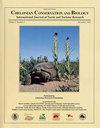Identifying Climate Refugia: A Framework to Inform Conservation Strategies for Agassiz's Desert Tortoise in a Warmer Future
IF 0.8
4区 生物学
Q3 ZOOLOGY
引用次数: 14
Abstract
Abstract Agassiz's desert tortoise, Gopherus agassizii, faces threats from climate change. With limited mobility to move long distances to more-suitable habitat as climate change advances, whether protecting tortoises in situ or translocating them out of harm's way, a critical conservation task is identifying refugia, lands that will remain suitable under the current climate and the projected, end of the 21st Century warming and drying. While researchers have modeled tortoise habitat suitability, they have done so at coarse scales and did not identify climate refugia that may become apparent only with a fine-scale approach. It is at that scale that managers can implement measures that will foster habitat protection for tortoises throughout their current range. In this case study, we employed fine-scale habitat suitability modeling to identify current habitat and climate refugia within and surrounding the Marine Corps Air Ground Combat Center (MCAGCC) at Twentynine Palms, California. We modeled nearly 284,000 ha of currently suitable tortoise habitat within an 858,800-ha study area. Projected maximum end-of-the-century summer temperatures could reduce the area of tortoise habitat 55% to 127,650 ha; however, almost 115,800 ha would overlap current tortoise habitat and would serve as climate refugia. Applied elsewhere, where tortoise protection must be balanced with other land uses, this approach could increase the efficacy of conservation for this threatened species. Nevertheless, until validated with field studies, habitat suitability models represent hypotheses as to current and future distributions of appropriate tortoise habitat. These hypotheses should foster additional research identifying whether tortoise densities and demographic structure are more secure and whether tortoises can adapt to shifting climates more effectively within than outside modeled refugia.确定气候避难所:在更温暖的未来为阿加西沙漠龟提供保护策略的框架
阿加西沙漠龟(Gopherus agassizii)面临气候变化的威胁。随着气候变化的推进,龟类长距离迁移到更适合的栖息地的能力有限,无论是在原地保护还是将它们转移到远离危害的地方,一项关键的保护任务是确定避难所,即在当前气候和预计的21世纪末变暖和干燥下仍然适合的土地。虽然研究人员已经对乌龟栖息地的适宜性进行了建模,但他们是在粗糙的尺度上进行的,并且没有确定气候避难所,而气候避难所只有在精细尺度的方法下才会变得明显。只有在这样的规模下,管理人员才能实施措施,在龟的现有活动范围内促进栖息地保护。在本案例研究中,我们采用了精细尺度的栖息地适宜性模型来确定位于加利福尼亚州二十九棕榈的海军陆战队空中地面作战中心(MCAGCC)及其周围的当前栖息地和气候避难所。我们在858,800公顷的研究区域内模拟了近284,000公顷目前适合的乌龟栖息地。预计本世纪末夏季最高气温将使陆龟栖息地面积减少55%至127,650公顷;然而,近115,800公顷的土地将与目前的乌龟栖息地重叠,并将成为气候避难所。在其他地方,龟类保护必须与其他土地利用相平衡,这种方法可以提高保护这一受威胁物种的效率。然而,在实地研究验证之前,栖息地适宜性模型代表了对乌龟适宜栖息地当前和未来分布的假设。这些假设应该促进进一步的研究,以确定龟的密度和人口结构是否更安全,以及龟在模型避难所内是否能比在模型避难所外更有效地适应变化的气候。
本文章由计算机程序翻译,如有差异,请以英文原文为准。
求助全文
约1分钟内获得全文
求助全文
来源期刊
CiteScore
1.70
自引率
14.30%
发文量
17
审稿时长
>12 weeks
期刊介绍:
Chelonian Conservation and Biology is a biannual peer-reviewed journal of cosmopolitan and broad-based coverage of all aspects of conservation and biology of all chelonians, including freshwater turtles, marine turtles, and tortoises. Manuscripts may cover any aspects of turtle and tortoise research, with a preference for conservation or biology. Manuscripts dealing with conservation biology, systematic relationships, chelonian diversity, geographic distribution, natural history, ecology, reproduction, morphology and natural variation, population status, husbandry, community conservation initiatives, and human exploitation or conservation management issues are of special interest.

 求助内容:
求助内容: 应助结果提醒方式:
应助结果提醒方式:


